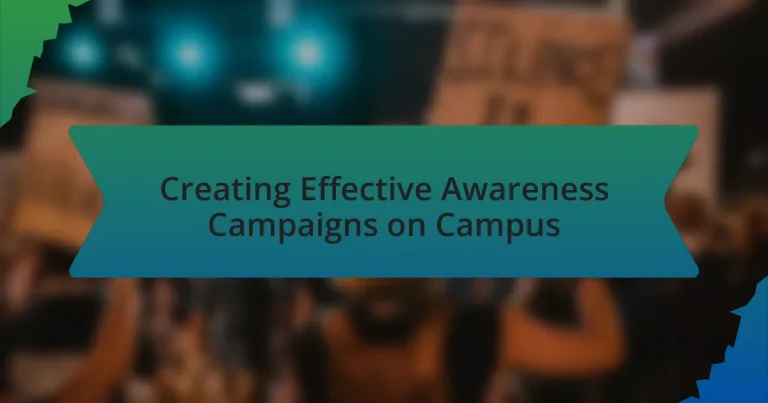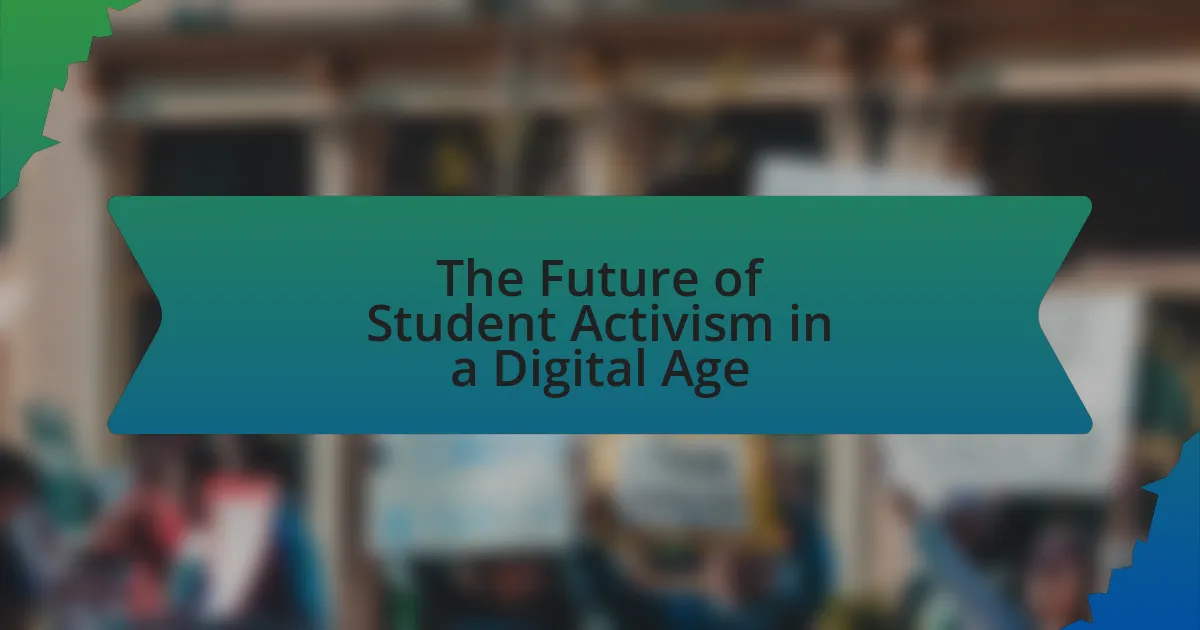Creating effective awareness campaigns on campus involves strategic initiatives aimed at educating and engaging students on critical issues such as mental health, sexual assault prevention, and sustainability. These campaigns utilize various methods, including social media, workshops, and visual displays, to enhance participation and information retention. Key characteristics of successful campaigns include clear messaging, targeted audience engagement, and measurable outcomes. The article also explores the importance of understanding the audience, effective strategies for campaign design, common challenges faced, and best practices for evaluating campaign effectiveness, ultimately highlighting the significant impact of awareness initiatives on campus communities.
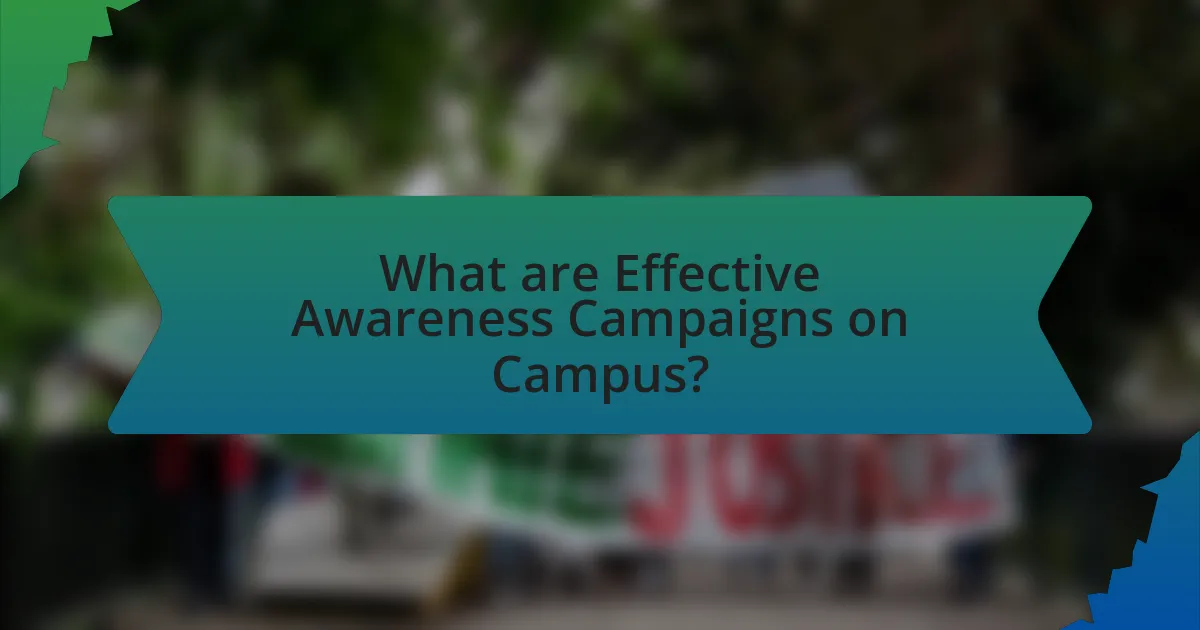
What are Effective Awareness Campaigns on Campus?
Effective awareness campaigns on campus are strategic initiatives designed to inform and engage students on specific issues, such as mental health, sexual assault prevention, or sustainability. These campaigns utilize various methods, including social media outreach, informational workshops, and visual displays, to maximize reach and impact. Research indicates that campaigns incorporating peer-to-peer education and interactive elements significantly enhance student participation and retention of information, as evidenced by a study published in the Journal of College Student Development, which found that interactive campaigns increased awareness by 40% compared to traditional methods.
How do awareness campaigns differ from other types of campaigns?
Awareness campaigns primarily aim to inform and educate the public about specific issues, whereas other types of campaigns, such as fundraising or promotional campaigns, focus on generating financial support or selling products. Awareness campaigns often utilize educational materials, social media, and community events to raise consciousness about topics like health, safety, or social justice, as evidenced by initiatives like the “It’s On Us” campaign, which addresses sexual assault awareness on college campuses. This distinction highlights that the primary goal of awareness campaigns is to change perceptions and behaviors through information dissemination, rather than directly soliciting donations or promoting services.
What are the key characteristics of successful awareness campaigns?
Successful awareness campaigns are characterized by clear messaging, targeted audience engagement, and measurable outcomes. Clear messaging ensures that the campaign’s purpose and goals are easily understood, which is crucial for capturing attention and fostering understanding. Targeted audience engagement involves identifying and reaching specific demographics that are most likely to resonate with the campaign’s message, thereby increasing relevance and impact. Measurable outcomes allow for the assessment of the campaign’s effectiveness through metrics such as participation rates, feedback, and behavioral changes, which provide concrete evidence of success. These characteristics are essential for creating impactful awareness campaigns that drive change and achieve desired objectives.
Why is it important to focus on awareness in a campus setting?
Focusing on awareness in a campus setting is crucial because it enhances student engagement and promotes a safer, more informed community. Awareness campaigns educate students about important issues such as mental health, sexual assault prevention, and substance abuse, leading to informed decision-making. For instance, a study by the American College Health Association found that campuses with active awareness programs reported a 30% decrease in incidents related to substance abuse. This demonstrates that targeted awareness initiatives can significantly impact student behavior and overall campus safety.
What goals should awareness campaigns aim to achieve?
Awareness campaigns should aim to achieve increased knowledge, behavioral change, and community engagement. These goals are essential for effectively addressing issues relevant to the campus community. For instance, campaigns focused on mental health awareness seek to educate students about available resources, thereby increasing utilization of mental health services by up to 30%, as reported by the American College Health Association. Additionally, campaigns can promote specific behaviors, such as safe drinking practices, which have been shown to reduce alcohol-related incidents on campuses by 25%. Lastly, fostering community engagement through awareness campaigns can enhance social cohesion and support networks among students, leading to a more inclusive campus environment.
How can campaigns raise awareness about specific issues?
Campaigns can raise awareness about specific issues by utilizing targeted messaging, engaging storytelling, and leveraging social media platforms. Targeted messaging ensures that the campaign speaks directly to the audience’s interests and concerns, making the issue more relatable. Engaging storytelling captures attention and evokes emotional responses, which can lead to increased empathy and understanding of the issue. For instance, a study by the Pew Research Center found that narratives can significantly enhance the effectiveness of awareness campaigns by making complex issues more accessible. Additionally, social media platforms amplify the reach of campaigns, allowing for rapid dissemination of information and fostering community engagement. According to a report by Hootsuite, over 4.2 billion people use social media globally, providing a vast audience for awareness initiatives.
What metrics can be used to measure the success of awareness campaigns?
Metrics used to measure the success of awareness campaigns include reach, engagement, conversion rates, and brand recall. Reach quantifies the total number of individuals exposed to the campaign, while engagement measures interactions such as likes, shares, and comments on social media platforms. Conversion rates indicate the percentage of individuals who took a desired action, such as signing up for a newsletter or attending an event, after being exposed to the campaign. Brand recall assesses how well the target audience remembers the campaign and its message, often measured through surveys. These metrics provide a comprehensive view of the campaign’s effectiveness in achieving its awareness objectives.
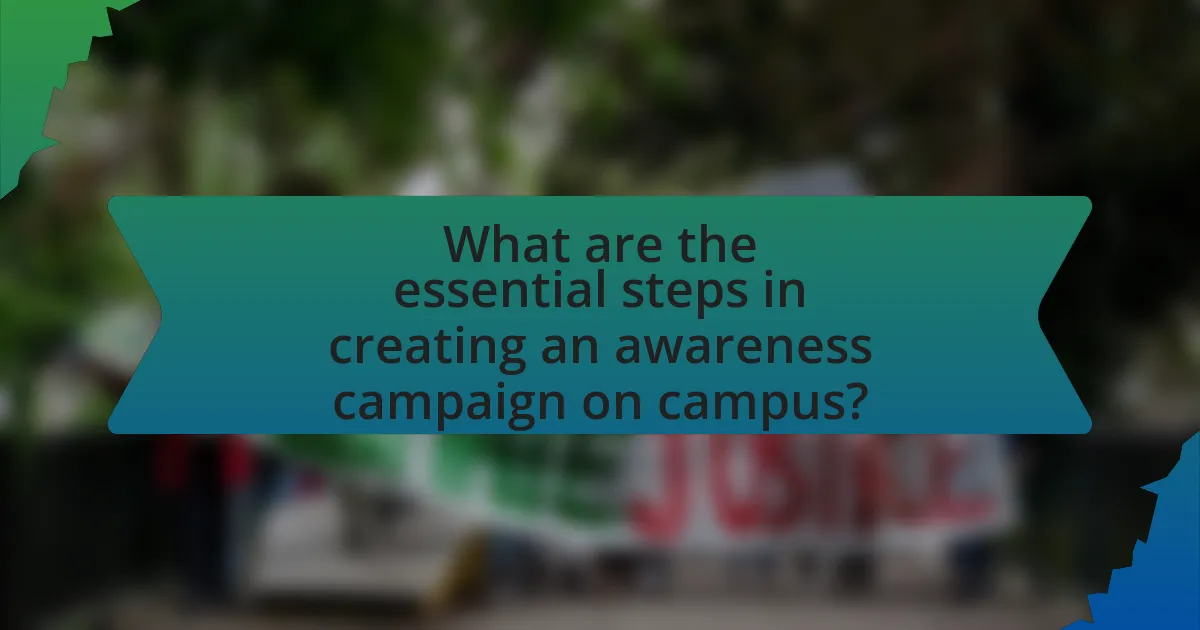
What are the essential steps in creating an awareness campaign on campus?
The essential steps in creating an awareness campaign on campus include defining the campaign’s goals, identifying the target audience, developing key messages, selecting appropriate channels for communication, and evaluating the campaign’s effectiveness. Defining the campaign’s goals ensures clarity on what the campaign aims to achieve, such as increasing awareness about mental health resources. Identifying the target audience allows for tailored messaging that resonates with specific groups, such as students or faculty. Developing key messages involves crafting concise and impactful statements that convey the campaign’s purpose. Selecting appropriate channels, such as social media, flyers, or campus events, maximizes reach and engagement. Finally, evaluating the campaign’s effectiveness through surveys or feedback helps assess its impact and informs future initiatives.
How do you identify the target audience for your campaign?
To identify the target audience for your campaign, conduct thorough research to analyze demographic, psychographic, and behavioral data relevant to your campaign’s goals. This involves utilizing surveys, focus groups, and existing data sources to gather insights about the preferences, needs, and characteristics of potential audience members. For instance, a study by Pew Research Center indicates that understanding the specific interests and values of different demographic groups can significantly enhance campaign effectiveness, as tailored messaging resonates more with targeted segments.
What methods can be used to gather information about the target audience?
Surveys and questionnaires are effective methods to gather information about the target audience. These tools allow for the collection of quantitative and qualitative data directly from individuals, providing insights into their preferences, behaviors, and demographics. For instance, a study by the Pew Research Center found that 68% of adults prefer online surveys for their convenience, which can lead to higher response rates and more accurate data collection. Additionally, focus groups can be utilized to facilitate in-depth discussions, revealing nuanced perspectives that surveys may not capture. According to a report by the American Marketing Association, focus groups can uncover motivations and attitudes, making them valuable for understanding audience sentiment.
Why is understanding the audience crucial for campaign effectiveness?
Understanding the audience is crucial for campaign effectiveness because it enables tailored messaging that resonates with specific demographics. When campaigns align with the values, interests, and needs of the target audience, engagement increases significantly. Research indicates that campaigns designed with audience insights can achieve up to 50% higher engagement rates compared to generic approaches. This is supported by a study from the American Marketing Association, which found that personalized marketing strategies lead to a 20% increase in conversion rates. Therefore, understanding the audience directly influences the success and impact of awareness campaigns on campus.
What strategies can be employed to design an impactful campaign?
To design an impactful campaign, utilize targeted messaging, engage stakeholders, and leverage multiple channels for outreach. Targeted messaging ensures that the campaign resonates with the specific audience by addressing their needs and interests, which can increase engagement rates. Engaging stakeholders, such as student organizations and faculty, fosters collaboration and enhances credibility, making the campaign more relatable. Leveraging multiple channels, including social media, email, and on-campus events, maximizes reach and reinforces the campaign message through various touchpoints. Research indicates that campaigns employing these strategies can achieve up to 50% higher engagement compared to those that do not.
How can storytelling enhance the effectiveness of the campaign?
Storytelling enhances the effectiveness of a campaign by creating emotional connections that engage the audience. When narratives are used, they can convey complex messages in relatable ways, making the campaign’s objectives clearer and more memorable. Research indicates that stories activate brain regions associated with emotion and memory, leading to increased retention of information. For instance, a study published in the journal “Psychological Science” found that people are more likely to remember facts when they are embedded in a story rather than presented as standalone data. This ability to evoke empathy and understanding can drive action and support for the campaign’s goals, ultimately leading to greater impact and participation.
What role do visuals and branding play in awareness campaigns?
Visuals and branding are crucial in awareness campaigns as they enhance recognition and engagement. Effective visuals capture attention quickly, making messages more memorable; studies show that people retain 65% of information when paired with relevant images compared to only 10% without. Branding establishes a consistent identity, fostering trust and credibility among the target audience. For instance, campaigns that utilize strong visual elements and cohesive branding strategies, such as color schemes and logos, can increase message retention and influence behavior, as evidenced by the American Marketing Association’s findings that consistent branding can increase revenue by up to 23%.
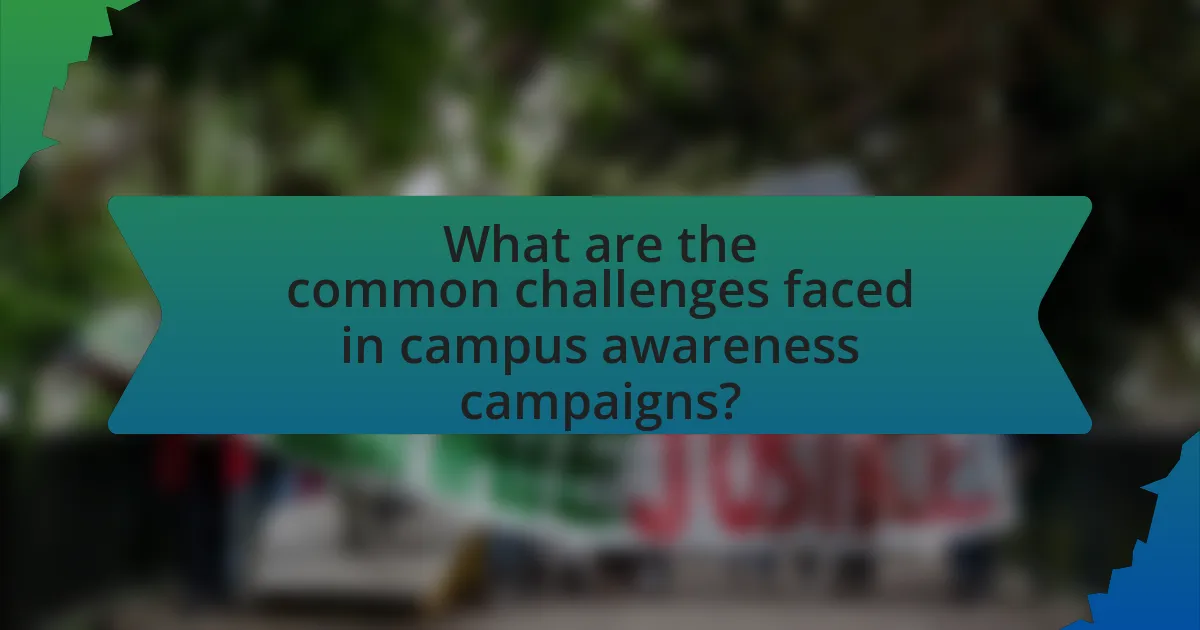
What are the common challenges faced in campus awareness campaigns?
Common challenges faced in campus awareness campaigns include limited engagement from students, insufficient funding, and difficulty in measuring impact. Limited engagement often arises from students’ busy schedules and lack of interest in the campaign topics, which can hinder participation. Insufficient funding restricts the resources available for promotional materials and events, making it challenging to reach a wider audience. Additionally, measuring the impact of campaigns can be difficult due to the lack of clear metrics and feedback mechanisms, leading to uncertainty about the effectiveness of the initiatives. These challenges are frequently documented in studies on campus outreach, highlighting the need for strategic planning and resource allocation to enhance campaign success.
How can limited resources affect campaign execution?
Limited resources can significantly hinder campaign execution by restricting the scope, reach, and effectiveness of the campaign. When a campaign lacks sufficient funding, personnel, or materials, it may struggle to effectively communicate its message, engage the target audience, or utilize appropriate channels for dissemination. For instance, a study by the American Marketing Association found that campaigns with limited budgets often resort to less effective marketing strategies, resulting in lower engagement rates and diminished impact. This limitation can lead to missed opportunities for outreach and ultimately reduce the overall success of the campaign.
What are some cost-effective strategies for running a campaign?
Cost-effective strategies for running a campaign include leveraging social media platforms, utilizing volunteer networks, and creating partnerships with local businesses. Social media allows for free or low-cost promotion to a wide audience, with platforms like Facebook and Instagram enabling targeted outreach. Engaging volunteers can reduce labor costs while fostering community involvement, as individuals often support causes they are passionate about. Additionally, partnerships with local businesses can provide resources, venues, or sponsorships, enhancing campaign visibility without significant financial investment. These strategies have been shown to maximize outreach while minimizing expenses, making them effective for campus awareness campaigns.
How can collaboration with campus organizations help overcome resource limitations?
Collaboration with campus organizations can help overcome resource limitations by pooling together diverse resources, expertise, and networks. When multiple organizations work together, they can share funding, facilities, and volunteer manpower, which enhances the overall capacity to execute awareness campaigns effectively. For instance, a study by the National Association of Student Personnel Administrators found that collaborative initiatives on campuses led to a 30% increase in resource availability for student-led projects. This synergy not only maximizes the impact of campaigns but also fosters a sense of community and shared purpose among students, ultimately leading to more successful outreach efforts.
What obstacles might arise in engaging the campus community?
Obstacles in engaging the campus community include lack of awareness, diverse interests, and limited participation. Lack of awareness can stem from insufficient communication about events or initiatives, leading to low turnout. Diverse interests among students can create challenges in appealing to a broad audience, as different groups may prioritize different issues. Limited participation often results from scheduling conflicts or perceived irrelevance of the campaign, which can hinder effective engagement. These factors collectively impede the success of awareness campaigns on campus.
How can campaigns address apathy or indifference among students?
Campaigns can address apathy or indifference among students by employing engaging and relatable messaging that resonates with their interests and values. For instance, utilizing social media platforms where students are active can increase visibility and participation, as studies show that 90% of young adults use social media regularly. Additionally, incorporating interactive elements such as polls, contests, or events can foster a sense of community and encourage active involvement. Research indicates that campaigns that involve peer influencers or relatable figures can significantly enhance engagement, as students are more likely to respond positively to messages from their peers.
What techniques can be used to foster participation and interest?
To foster participation and interest in awareness campaigns on campus, techniques such as interactive workshops, social media engagement, and incentive programs can be employed. Interactive workshops encourage hands-on involvement, allowing participants to actively engage with the campaign’s themes, which has been shown to increase retention and interest levels. Social media engagement leverages platforms popular among students, facilitating real-time interaction and sharing of campaign content, thus broadening reach and participation. Incentive programs, such as contests or rewards for participation, motivate students to engage more deeply, as evidenced by studies indicating that incentives can significantly boost involvement rates in campus activities.
What are the best practices for evaluating the effectiveness of an awareness campaign?
The best practices for evaluating the effectiveness of an awareness campaign include setting clear objectives, utilizing pre- and post-campaign surveys, analyzing engagement metrics, and conducting focus groups. Clear objectives provide a benchmark for success, while pre- and post-campaign surveys measure changes in awareness and attitudes among the target audience. Engagement metrics, such as social media shares and event attendance, offer quantitative data on reach and impact. Focus groups allow for qualitative insights into audience perceptions and behaviors. Research indicates that campaigns with defined goals and measurable outcomes are more likely to demonstrate effectiveness, as evidenced by a study published in the Journal of Marketing Research, which found that campaigns with specific objectives achieved 30% higher engagement rates compared to those without.
How can feedback be collected from participants after the campaign?
Feedback can be collected from participants after the campaign through surveys, interviews, and focus groups. Surveys can be distributed via email or online platforms, allowing participants to provide quantitative and qualitative feedback efficiently. Interviews can offer deeper insights by engaging participants in one-on-one discussions, while focus groups can facilitate group discussions to gather diverse perspectives. Research indicates that using a combination of these methods increases response rates and the richness of the feedback collected, enhancing the overall evaluation of the campaign’s effectiveness.
What tools can be used to analyze campaign data and outcomes?
Tools that can be used to analyze campaign data and outcomes include Google Analytics, social media analytics platforms, and survey tools like SurveyMonkey. Google Analytics provides insights into website traffic and user behavior, allowing campaign managers to assess the effectiveness of online outreach. Social media analytics platforms, such as Hootsuite and Sprout Social, offer metrics on engagement, reach, and audience demographics, which are crucial for evaluating social media campaigns. Survey tools like SurveyMonkey enable the collection of direct feedback from participants, helping to measure the impact of awareness campaigns on campus. These tools collectively provide a comprehensive view of campaign performance, facilitating data-driven decision-making.
What practical tips can enhance the success of campus awareness campaigns?
To enhance the success of campus awareness campaigns, it is essential to engage students through interactive and relatable content. Engaging content, such as workshops, social media challenges, and peer-led discussions, fosters participation and increases awareness. Research indicates that campaigns utilizing interactive elements can boost engagement by up to 50%, as students are more likely to participate when they feel personally involved. Additionally, collaborating with student organizations and influencers can amplify reach and credibility, as these groups often have established trust within the campus community. Effective timing, such as aligning campaigns with relevant events or academic calendars, also maximizes visibility and participation.
How can leveraging social media improve campaign reach?
Leveraging social media can significantly improve campaign reach by enabling targeted communication and facilitating viral sharing. Social media platforms allow campaigns to reach specific demographics through targeted ads and organic posts, increasing visibility among relevant audiences. For instance, a study by Pew Research Center found that 69% of adults in the U.S. use social media, providing a vast audience for campaigns. Additionally, content shared on social media can be rapidly disseminated through user networks, amplifying the message beyond the initial audience. This viral potential is evidenced by campaigns that have successfully engaged users to share content, leading to exponential growth in reach and engagement.
What are some innovative ideas for engaging students in awareness campaigns?
Innovative ideas for engaging students in awareness campaigns include interactive workshops, social media challenges, and gamification strategies. Interactive workshops allow students to participate actively, fostering a deeper understanding of the campaign’s message. Social media challenges, such as hashtag campaigns, encourage students to share their experiences and spread awareness within their networks, leveraging platforms where they are most active. Gamification strategies, like competitions or quizzes related to the campaign topic, can increase engagement by making learning fun and rewarding. These methods have been shown to enhance participation and retention of information, as evidenced by studies indicating that interactive and competitive elements significantly boost student involvement in educational initiatives.
